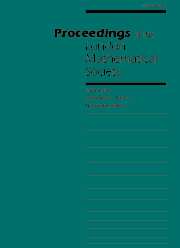Article contents
THE SHARP BOUND FOR THE DEFORMATION OF A DISC UNDER A HYPERBOLICALLY CONVEX MAP
Published online by Cambridge University Press: 07 August 2006
Abstract
We complete the determination of how far convex maps can deform discs in each of the three classical geometries. The euclidean case was settled by Nehari in 1976, and the spherical case by Mejía and Pommerenke in 2000. We find the sharp bound on the Schwarzian derivative of a hyperbolically convex function and thus complete the hyperbolic case. This problem was first posed by Ma and Minda in a series of papers published in the 1980s. Mejía and Pommerenke then produced partial results and a conjecture as to the extremal function in 2000. Their function maps onto a domain bounded by two proper geodesic sides, a ‘hyperbolic strip’. Applying a generalization of the Julia variation and a critical Step Down Lemma, we show that there is an extremal function mapping onto a domain with at most two geodesic sides. We then verify using special function theory that, among the remaining candidates, the two-sided domain of Mejía and Pommerenke is in fact extremal. This correlates nicely with the euclidean and spherically convex cases in which the extremal is known to be a map onto a two-sided ‘strip’.
Keywords
Information
- Type
- Research Article
- Information
- Proceedings of the London Mathematical Society , Volume 93 , Issue 2 , September 2006 , pp. 395 - 417
- Copyright
- 2006 London Mathematical Society
- 1
- Cited by

